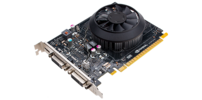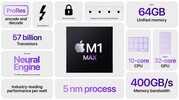NVIDIA GeForce GTX 750 Ti vs Apple M1 Max 32-Core GPU
NVIDIA GeForce GTX 750 Ti
► remove from comparison
The NVIDIA GeForce GTX 750 Ti is a mid-range desktop graphics card that was announced early 2014. It is based on the first generation of the Maxwell architecture, namely the GM107 chip. Maxwell sets its focus on energy efficiency and was able to outperform the predecessor Kepler and AMD chips in similar performance regions. The GTX 750 Ti supports DirectX 11.2 but only feature level 11_0.
The GeForce GTX 750 Ti is comparable to the Nvidia Geforce GTX 860M for laptops that features the same chip with slightly slower clock rates and therefore also performance.
The 3D performance lies between the Radeon R7 260X and R7 265X from AMD or between the GTX 750 and GTX 660 from Nvidia. In our tests, the 750 Ti was not able to achieve playable framerates in demanding games and highest settings in 1920x1080 (see benchmarks below).
The power consumption as already mentioned is a strong suite for the GTX 750 Ti and it excels the e.g. slightly slower Radeon R7 260X by a great margin (gaming).
Apple M1 Max 32-Core GPU
► remove from comparison
The Apple M1 Max 32-Core-GPU is an integrated graphics card by Apple offering all 32 cores in the M1 Max Chip. The 4,096 ALUs offer a theoretical performance of up to 10.4 Teraflops.
The graphics card has no dedicated graphics memory but can use the fast LPDDR5-6400 unified memory with a 512 bit bus (up to 400 GBit/s).
The GPU clocks between 389 and 1296 MHz and offers no short term boost (389, 486, 648, 778, 972, 1296 MHz steps according to Powermetrics). The GPU is intended to use Apple Metal 2 API and could still be based on the older PowerVR architectures (last used in the Apple A10).
The Apple M1 Max is manufactured in the modern 5nm process at TSMC and offers an excellent energy efficiency.
| NVIDIA GeForce GTX 750 Ti | Apple M1 Max 32-Core GPU | ||||||||||||||||||||||||||||
| Apple M1 Series |
|
| |||||||||||||||||||||||||||
| Codename | GM107 | ||||||||||||||||||||||||||||
| Architecture | Maxwell | ||||||||||||||||||||||||||||
| Pipelines | 640 - unified | 32 - unified | |||||||||||||||||||||||||||
| Core Speed | 1020 - 1085 (Boost) MHz | 1296 MHz | |||||||||||||||||||||||||||
| Memory Speed | 2700 MHz | ||||||||||||||||||||||||||||
| Memory Bus Width | 128 Bit | 512 Bit | |||||||||||||||||||||||||||
| Memory Type | GDDR5 | LPDDR5-6400 | |||||||||||||||||||||||||||
| Max. Amount of Memory | 2048 MB | ||||||||||||||||||||||||||||
| Shared Memory | no | no | |||||||||||||||||||||||||||
| API | DirectX 11.2, Shader 5.0, OpenGL 4.4 | ||||||||||||||||||||||||||||
| Power Consumption | 60 Watt | 44 Watt | |||||||||||||||||||||||||||
| Transistors | 1.9 Billion | ||||||||||||||||||||||||||||
| technology | 28 nm | 5 nm | |||||||||||||||||||||||||||
| Features | 3D Vision, PhysX, CUDA, GPU Boost 2.0, GeForce Experience, Adaptive VSync | ||||||||||||||||||||||||||||
| Date of Announcement | 18.02.2014 | 10.11.2020 | |||||||||||||||||||||||||||
| Link to Manufacturer Page | www.nvidia.de | www.apple.com | |||||||||||||||||||||||||||
| Theoretical Performance | 10.4 TFLOPS FP32 | ||||||||||||||||||||||||||||
| Memory Bandwidth | 400 GB/s |
| |||||||||
Benchmarks
3DM Vant. Perf. total + NVIDIA GeForce GTX 750 Ti
Cinebench R15 OpenGL 64 Bit + Apple M1 Max 32-Core GPU
GFXBench T-Rex HD Offscreen C24Z16 + Apple M1 Max 32-Core GPU
Average Benchmarks NVIDIA GeForce GTX 750 Ti → 0% n=0
Average Benchmarks Apple M1 Max 32-Core GPU → 0% n=0
* Smaller numbers mean a higher performance
1 This benchmark is not used for the average calculation
Game Benchmarks
The following benchmarks stem from our benchmarks of review laptops. The performance depends on the used graphics memory, clock rate, processor, system settings, drivers, and operating systems. So the results don't have to be representative for all laptops with this GPU. For detailed information on the benchmark results, click on the fps number.

Borderlands 3
2019
F1 2014
2014
The Evil Within
2014
Ryse: Son of Rome
2014
Alien: Isolation
2014
Fifa 15
2014
Sims 4
2014
Risen 3: Titan Lords
2014
GRID: Autosport
2014
Watch Dogs
2014
Thief
2014
Call of Duty: Ghosts
2013
Battlefield 4
2013
Saints Row IV
2013
Metro: Last Light
2013
BioShock Infinite
2013
Tomb Raider
2013
Crysis 3
2013
Far Cry 3
2012
Hitman: Absolution
2012
Guild Wars 2
2012Average Gaming NVIDIA GeForce GTX 750 Ti → 100%
Average Gaming 30-70 fps → 100%
| NVIDIA GeForce GTX 750 Ti | Apple M1 Max 32-Core GPU | |||||||||||||
|---|---|---|---|---|---|---|---|---|---|---|---|---|---|---|
| low | med. | high | ultra | QHD | 4K | low | med. | high | ultra | QHD | 4K | |||
| Borderlands 3 | 66 | 54 | 47 | 40 | 33 | 20.6 | ||||||||
| Total War: Three Kingdoms | 247 | 129 | 82 | 60 | 39 | 20 | ||||||||
| Shadow of the Tomb Raider | 140 | 104 | 97 | 88 | 61 | 33 | ||||||||
| NVIDIA GeForce GTX 750 Ti | Apple M1 Max 32-Core GPU | |||||||||||||
| low | med. | high | ultra | QHD | 4K | low | med. | high | ultra | QHD | 4K | < 30 fps < 60 fps < 120 fps ≥ 120 fps | | | | | | | < 30 fps < 60 fps < 120 fps ≥ 120 fps | 1 2 | 1 1 1 | 1 2 | 1 2 | 2 1 | 2 1 |
For more games that might be playable and a list of all games and graphics cards visit our Gaming List



















